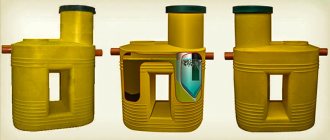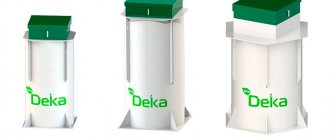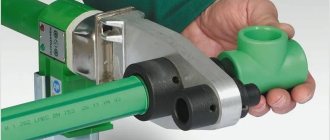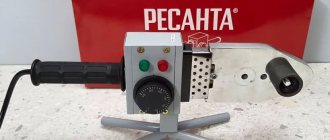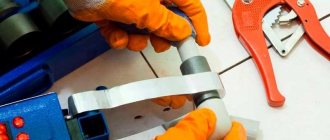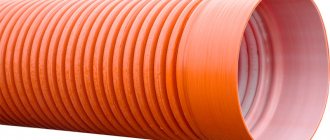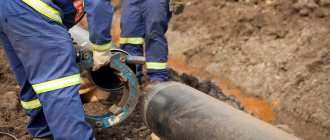The most high-tech material for the manufacture of pipelines is polypropylene. Due to its technical characteristics, properties, and low price, it is superior to metal products. Polypropylene pipes are sold at a hardware or plumbing store. Anyone can install a plastic pipeline.
Polypropylene pipes for heating
Properties
Polypropylene pipes have a number of properties that distinguish them from products made from other materials:
- low density;
- high strength;
- resistance to alkalis and acids;
- good wear resistance;
- protection against rust formation;
- low electrical conductivity;
- resistance to water hammer and multiple bends;
- harmlessness during operation;
- easy weldability when soldering with a soldering iron.
To improve the properties of polypropylene, additional additives may be added to the composition when manufacturing parts from this material.
Applying propylene to the internal surfaces of pipes
We are talking about metal-plastic pipes that have an outer polypropylene layer. They tolerate increases in temperature well.
The disadvantages of these products include the following:
- The presence of several layers. Three different substances are connected into one structure using an adhesive method.
- The fitting is attached only to the outer layer, which makes the connection not very strong.
- The transported medium often comes into direct contact with the reinforcement, which is why the material can gradually wear out.
Specifications
Technical characteristics of polypropylene pipes:
- Frost resistance indicator - up to -15 degrees. Pipes made from this material are not suitable for the manufacture of external water pipes.
- Low thermal conductivity. Thanks to this, the liquid reaches from one end of the pipeline to the other with a minimum temperature difference.
- The density of polypropylene is 0.91 kg/cm2.
- Chemical resistance of the material.
- High linear expansion rate.
- Mechanical strength - 35 N/mm.
- Softening of polypropylene begins at 140 degrees.
- Heat resistance to coolants - up to 120 degrees.
- Plastic melting starts at 170 degrees.
- The operating pressure range is 10–25 atmospheres.
Pipes from this material are made with diameters from 10 to 125 mm. The parts are connected using a special soldering iron. Thanks to soldering, a strong, airtight seam is obtained.
When installing polypropylene pipes, it is important to take into account its high linear expansion. When connecting household appliances and radiators, special compensators must be installed.
Ventilation material
Ventilation pipes ensure the flow of fresh air into the room and the removal of exhaust air: their strength in this case is not the main criterion. The main thing is that these products were lightweight, since they are often supported only by partitions or suspended ceilings.
Residential premises are equipped with pipes with a diameter of 100 or 125 mm; industrial systems will require preliminary calculations. The cross-sectional shape of such products can be square, round, oval or rectangular. The installation process uses the socket method, so no welding machine is required.
Color
PP pipes come in different shades. The color indicates the operational features of the part:
- White - used for the manufacture of pipelines inside apartments and private houses. Easy to connect, which speeds up installation. Not suitable for making outdoor water pipes. The material quickly loses strength when the temperature drops below 0 degrees.
- Gray - suitable for the manufacture of heating systems. This is due to its high thermal stability.
- Black - sewer drains and drainage channels are made from such tubes. By adding chemicals to the composition, manufacturers improve the technical characteristics of products.
- Green - used for the manufacture of liquid supply systems for garden plots and vegetable gardens. Cannot withstand high water pressure.
Green colored pipelines should be checked more often than others. Due to low strength, leaks and breakdowns often occur in the system.
Black polypropylene pipes
Reinforcement with fiberglass
The PPR-FB-PPR marking indicates that such a pipe consists of two polypropylene layers separated by a fiberglass gasket. This type of pipe is also called fiberglass.
Fiberglass reinforcement has some advantages:
- There is no need for calibration or cleaning during installation.
- Soldering here is the same as when connecting solid plastic or any polymer-protected pipes. This helps to increase the speed of work and reduce its cost.
- Thanks to fiberglass, delamination of polypropylene pipes is not observed. This is due to the uniformity of its structure, because the central fiberglass layer is literally fused into the polypropylene structure.
- Due to fiberglass, products become more rigid.
The disadvantage of fiberglass-type pipes is that they have greater thermal elongation when compared with pipes with aluminum reinforcement.
Assortment
The range of PP pipes consists of several types:
- PPs is a range of rolled pipes, in the manufacture of which a highly flammable polymer is used. Thanks to this, finished products can withstand temperatures of 95 degrees for a long time. Durable heating systems are made from it.
- PPB - products made from a complex block copolymer. Since the products can withstand high pressure, they are suitable for the manufacture of pressure heating systems and cold water supply.
- PPR - made from random copolymer. Suitable for assembling underfloor heating systems, hot and cold water supply.
- PPH is a cheap type of polypropylene. Cold water and ventilation systems are made from such tubes.
Main pipe diameters according to GOST
The diameter in the marking of PPR water pipes is indicated as the outer diameter. Moreover, the larger it is and the higher the PN, the thicker the pipe wall. Products of 16–20 mm are used for installing water pipes throughout the apartment and cottage. 25–32 mm is for the riser. Larger diameter options are intended for pipelines in multi-storey buildings, main networks and sewerage.
How to correctly calculate the diameter of a pipe based on its purpose
Kinds
Types of polypropylene pipes depending on the design:
- solid - made of homogeneous plastic;
- reinforced - in production two or more materials are used that are combined with each other.
Reinforced tubes have several differences from solid parts:
- the outer side is coated with aluminum foil;
- additional aluminum coating may be located inside the part;
- tubes can be reinforced with fiberglass.
Classification of polypropylene pipes with reinforcement:
- Aluminum. They can be reinforced with a continuous layer or a mesh with small holes. The presence of an additional layer of metal ensures a decrease in the thermal expansion of the plastic, an increase in strength, and pressure resistance.
- Fiberglass. They have a layered structure. The main ones are two layers of polypropylene, between which there is a reinforcing layer of fiberglass.
- Metal-polymer. Consist of 5 layers. Polypropylene is located outside and inside. Intermediate layers are adhesive. The central one is aluminum.
The technical characteristics of reinforced products are higher than those of parts made from a homogeneous material.
Various polypropylene pipes
Polypropylene taps
When using plastic pipes, it will be more aesthetically pleasing to use taps coated with polypropylene. This is usually what inexperienced plumbers think about. In fact, it is better to use regular brass taps with a transition to polypropylene through a coupling.
At first glance, a faucet filled with a polypropylene shell seems to be the ideal solution. Does not spoil the overall appearance of the plastic pipeline, does not require additional parts for connection to a common unit.
The fact is that taps filled with plastic have lower reliability. The faucet consists of two fundamentally different materials (metal and plastic), with different densities and thermal expansions. Due to different properties, problems often arise in the form of leaks or breakdowns. Global manufacturers recognize the shortcomings of polypropylene cranes and are working on the mistakes, but it is too early to say with complete confidence about reliable cranes of this type.
A much more reliable solution would be a brass tap with two threaded couplings. The coupling also contains two materials, metal and plastic, but these parts are stationary, unlike a tap.
In addition to reliability, there is also an aesthetic side to using conventional taps: the tap can be rotated along its axis and given a more even position. The sealed plastic tap cannot be turned on the pipe; you need to do the soldering very clearly the first time; the soldering can only be corrected by soldering in a new tap.
In fact, brass faucets provide more options. They can be replaced without soldering, if the faucet comes with an American one; the connection is detachable in case of other repairs. American becomes relevant when installed in hard-to-reach places.
In addition, conventional cranes are, as a rule, smaller in size, and the range of products is much wider.
Just like brass, polypropylene taps come in two types: valve and ball. Please note that ball valves can only be used in two positions: open and closed, adjustment is not allowed.
All manufacturers say so. However, on this score, in the process of working as a plumber, a different opinion was formed...
The above is true for expensive, high-quality products, but in our realities, as a rule, we have to deal with budget faucets. So, if we compare two budget products, a valve and a ball valve, the ball wins in terms of reliability, even with constant adjustment. Although the valve is specifically designed for regulation, it fails very quickly. This opinion has been formed over many years of work. These considerations are valid both for brass shut-off and control valves, and for products filled with polypropylene.
And finally, I would like to say: you should not skimp on taps, as well as on all plumbing fixtures. Pipes and all components should be purchased from reliable stores; this should be done slowly and thoughtfully!
Marking
To find out the characteristics of the material from which the pipes are made, you need to look at the markings with which they are marked. Decoding the letter index:
- PP - designation of ordinary polypropylene;
- PP-R - polypropylene random polymer;
- PP-RC - designation of type 3 random copolymer;
- PP-RCT is an improved type random copolymer.
Industrial pipelines and agricultural systems are made from PP-RC pipes.
Marking according to characteristics:
- PN10 - designation of parts that can withstand pressure up to 10 atmospheres. The maximum permissible temperature is 45 degrees. This material is suitable for the manufacture of cold water supply pipes.
- PN16 - liquid or gas pressure can reach up to 16 atmospheres. Temperature range: up to 60 degrees. Suitable for assembling underfloor heating systems.
- PN20 - withstand pressure up to 20 atmospheres. Permissible temperature is 95 degrees. Central heating pipelines are made from such elements.
- PN25 - consist of plastic with a layer of aluminum or fiberglass. Withstand pressure up to 25 atmospheres and temperature - 95 degrees.
When making pipelines for hot and cold water supply or heating circuits, products marked PN25 are more often used.
Advantages and disadvantages
Advantages:
- The walls of the parts are smooth inside. Plaque does not accumulate on them.
- The material suppresses the noise of water flowing through the system.
- Low thermal conductivity prevents condensation from accumulating on the outside of the products.
- Light weight, allowing for independent installation without the help of a second person.
- They are not destroyed by exposure to chemicals.
- There is no rust on the pipes, which increases their durability.
- The active service life is about 50 years. If the system is designed for cold water supply, the service life increases to 100 years.
Disadvantages of polypropylene pipes:
- Low heat resistance. The material cannot withstand prolonged exposure to high temperatures.
- Lack of ability to bend at a large angle.
- Destruction due to prolonged exposure to ultraviolet radiation
- High coefficient of thermal expansion. Therefore, during installation it is necessary to install compensators.
If you take into account the disadvantages, you can make a durable pipeline that will work for a long period of time without breakdowns.
Disadvantage of polypropylene pipes
Installation features
It is not recommended to use the method of joining with glue, since the walls of polypropylene are very smooth, which does not allow achieving the required joint strength. The ends of the pipes are joined only by heating; diffusion creates a strong seam. Moreover, pipes never break in these places.
To install a polypropylene pipe system you will need the following tools:
- pipe cutter;
- soldering device.
It should be taken into account that when taking measurements, minus those areas that will be soldered into corners or couplings. This is approximately 15 mm.
Stages of installation work:
- Measurements of the areas through which the pipes will pass.
- Cutting and marking with a pencil the correct position of the fittings, since after the plastic has hardened, the incorrect position cannot be corrected.
- Both parts are heated on a special pipe soldering device, then connected along the marked lines and held for 6 seconds.
No more than 4 seconds should pass from the moment of heating to the connection, otherwise the material will cool down and the quality of the joint will be poor; water may subsequently leak in this place. Before heating, the ends of the pipes are degreased with alcohol or gasoline.
Along the route of the pipeline, plastic clips are installed to secure the pipes. They should not tightly cover the product so that thermal expansion is compensated. The connections are considered non-separable, therefore, if a section of the line is damaged, it must be completely replaced.
Criterias of choice
When choosing polypropylene tubes, you need to pay attention to several factors:
- required temperature conditions;
- maximum pressure of liquid or gas;
- service life;
- diameter
Manufacturers:
- Banninger is a German company that makes its products from random copolymers. It is suitable for assembling water supply systems and drinking water supply.
- Valtec is an Italian company that produces thin-walled aluminum and fiberglass reinforced parts.
- Kalde is a Turkish company that produces products from pure polypropylene, which can be reinforced with aluminum foil and fiberglass.
- Wavin Ekoplastik is a Czech manufacturer that produces tubes that can withstand pressures of up to 20 atmospheres. Additionally they can be reinforced with aluminum foil.
- SPK is a Turkish company that produces inexpensive parts of good quality.
- Tebo is a Turkish manufacturer that produces products made of pure plastic or with a reinforcing coating.
Polypropylene pipes quickly replaced metal products from everyday use. They incorporate the best of different materials, but are sold at a low price. Easy installation allows you to save additional money if you do the work yourself.




